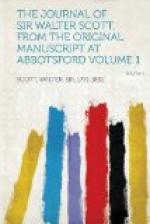[443] Mary Campbell, Lady Ruthven, for whom the picture was painted, was not only the friend of Scott, but she held relations more or less close with nearly every one famous in Art and Literature during the greater part of the nineteenth century. No mean artist herself, and though, perhaps, not a clever letter-writer, she had among her correspondents some of the most brilliant men of her day. She survived all her early friends, but had the gift of being attractive to the young, and for three generations was the delight of their children and grandchildren. Those who were privileged to share in the refined hospitality of Winton, never forgot either the picturesque old house (the supposed Ravenswood Castle of the Bride of Lammermoor), or its venerable mistress as she sat of an evening in her unique drawing-room, the walls of which were adorned with pictures of Grecian temple and landscape, her own handiwork in days long gone by when she was styled by her friends Queen of Athens. Her conversation, after she was ninety, was fresh and vigorous; and, despite blindness and imperfect hearing, she kept herself well acquainted with the affairs of the day. The last great speech in Parliament, or the newest bon mot, were equally acceptable and equally relished. Her sense of humour and fun made her, at times, forget her own sufferings, and her splendid memory enabled her to while away many a sleepless hour by repeating long passages from the Bible or Milton. The former she had so much in her heart that it was scarcely possible to believe she was not reading from the Book. Above all was her truly divine gift of charity, the practical application of which, in her every-day life, was only bounded by her means.
It was said of her by one who knew her well—
“She lived to a great age, dispensing kindness and benevolence to the last, and cheered in the sore infirmities of her later years by the love of friends of all ranks, and all parties of all ages.
“The Living Lamp of Lothian, which from Winton, has so long shed its beneficent lustre, has been extinguished, but not so will be lost the memory of the gifted lady, for by not a few will still be cherished the recollection of her noble nature, and of her Christian life.”
Lady Ruthven prized the picture referred to. She would not, as Sir Francis Grant relates,[D] permit him to touch the canvas after it left the Abbotsford studio; and it remained a cherished possession which she took pride in showing to appreciative guests, pointing out the details of face and form which she still saw with that inner eye, which time had not darkened.
It is now in the National Portrait Gallery of Scotland—bequeathed to the nation with other pictures, as well as the magnificent collection of Greek archaeological objects gathered by herself and Lord Ruthven in their early married life. She was born in 1789, and died in 1885.
[444] Robert Dundas of Arniston, Esq., the worthy representative of an illustrious lineage, died at his paternal seat in June 1838.—J.G.L. See Arniston Memoirs—Three Centuries of a Scottish House, 1571-1838. Edin. 8vo, 1887.




